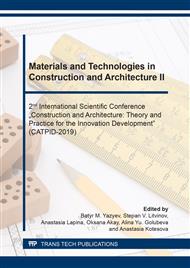p.627
p.633
p.638
p.646
p.653
p.659
p.665
p.672
p.676
Relation between Breaking Stresses in the Strength Calculations of Reinforced Concrete Elements under the Deformation Mode in the Edition of Russian and Foreign Regulatory Documents
Abstract:
Сorrespondence was established between the compressive strength grades of concrete numerically equal to the guaranteed compressive strength of a standard concrete cube and a standard concrete cylinder. Designated concrete resistances are assigned for the limiting states of the first group with a compressive strength grade of concrete. For the corresponding concrete grades, the reduction to unambiguous strains values at the base diagrams points is justified: at the top and at the end of the falling branch of the curvilinear diagrams. In accordance with the regulatory requirements, restrictions are imposed on the stress levels at the end of the falling diagrams branch at the maximum normalized strains values. Mathematical models establishing a uniform format for calculating single-valued strains values at base points of concrete diagrams have been developed taking into account accepted functional relations and the their assignment rules using the requirements documents tables. It is shown that with equal strains values and stresses at base points, analytical expressions describing diagrams recommended by requirement documents, different in their structure, give their identical outlines, the diagrams branches are the same. Relation between design models in the edition of Russian and foreign regulatory documents is correlated by the comparison of integral diagrams parameters and breaking stresses obtained with the calculation of reinforced concrete element under the deformation mode. As integral parameters of concrete deformation diagrams, it is recommended to use the areas bounded by diagrams branches and diagrams fineness coefficient. The diagram area for given values of the element curvature is equivalent to the magnitude of the breaking stress in the compressed concrete zone in the bent and compressed elements, and the stress diagram in outline corresponds to this diagram.
Info:
Periodical:
Pages:
653-658
Citation:
Online since:
December 2019
Authors:
Keywords:
Price:
Сopyright:
© 2020 Trans Tech Publications Ltd. All Rights Reserved
Share:
Citation:


